| Pages:
1
..
64
65
66
67
68
..
77 |
anti
Harmless

Posts: 32
Registered: 17-2-2020
Member Is Offline
Mood: Mood: Mood:
|
|
Quote: Originally posted by Herr Haber  | And maybe get rid of the non chemistry pictures ?
(I dont want to imagine what they were before shrinking, they're still too big) |
Fine.
Is it good now?
|
|
|
j_sum1
Administrator
       
Posts: 6320
Registered: 4-10-2014
Location: At home
Member Is Offline
Mood: Most of the ducks are in a row
|
|
Thanks anti for fixing that up. I was not sure how to edit that for you.
Feel free to redo the chem pics. Uploading a file works well. Click previw to check. Not sure what happened with the img tag, but the other method is
reliable.
Welcome to SM.
|
|
|
Texium
Administrator
       
Posts: 4580
Registered: 11-1-2014
Location: Salt Lake City
Member Is Offline
Mood: PhD candidate!
|
|
Today at work I witnessed what happens when a flask is heated WAY too hot while under vacuum!
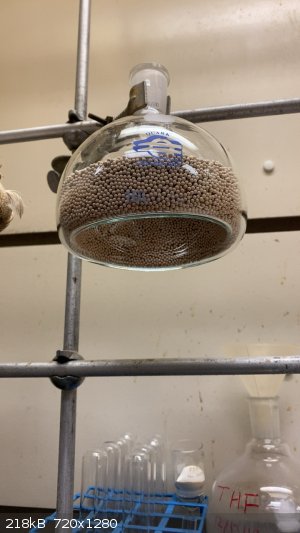 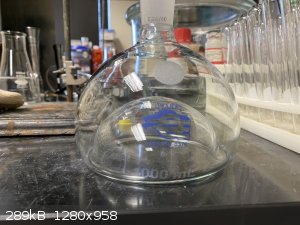
It mushroomed!
|
|
|
DraconicAcid
International Hazard
    
Posts: 4332
Registered: 1-2-2013
Location: The tiniest college campus ever....
Member Is Offline
Mood: Semi-victorious.
|
|
Ha! I had that happen to one of my sample tubes, long ago, when I worked with molten salts. I was trying to dry lithium chloride under vacuum, but
heated it just enough that the glassware softened. I wound up with a very flat Schlenk tube.
Please remember: "Filtrate" is not a verb.
Write up your lab reports the way your instructor wants them, not the way your ex-instructor wants them.
|
|
|
wg48temp9
National Hazard
   
Posts: 783
Registered: 30-12-2018
Location: not so United Kingdom
Member Is Offline
|
|
Wow! Was it heated in a mantle?
Why did the flask get so hot? Was it because the mantle was at full power and once the beads were dry and therefore not cooled by evaporation of the
solvent the flask got sufficiently hot to soften and then deform? Was the mantel damaged? How could it have been avoided? Presumably by monitoring the
flask temperature.
I am wg48 but not on my usual pc hence the temp handle.
Thank goodness for Fleming and the fungi.
Old codger' lives matters, wear a mask and help save them.
Be aware of demagoguery, keep your frontal lobes fully engaged.
I don't know who invented mRNA vaccines but they should get a fancy medal and I hope they made a shed load of money from it.
|
|
|
Texium
Administrator
       
Posts: 4580
Registered: 11-1-2014
Location: Salt Lake City
Member Is Offline
Mood: PhD candidate!
|
|
Pretty much spot on. However, the mantle was hooked up to a variac, and the variac was only at 65% 
The funny thing is, I think as the glass pulled away from contact with the heating mantle, it slowly cooled and hardened again, and that’s why it
didn’t fully implode and held its shape without deforming any more. Surprisingly, the heating mantle was not fused to it, and still works perfectly
fine!
|
|
|
DavidJR
National Hazard
   
Posts: 908
Registered: 1-1-2018
Location: Scotland
Member Is Offline
Mood: Tired
|
|
Yeah I've done that to an erlenmeyer on a hotplate. I was also trying to dry sieves.
Much better method is to use a microwave oven.
|
|
|
Tsjerk
International Hazard
    
Posts: 3032
Registered: 20-4-2005
Location: Netherlands
Member Is Offline
Mood: Mood
|
|
I fried a microwave/oven a week ago when I tried to dry sieves. I accidentally turned on the microwave function of the oven and set it to 90
minutes... When I came back after 30 minutes the plastic rotation stand for the glass plate was smoking and the beaker glass was molten to the glass
bottom plate.
It did get me a transformer to build a Tesla coil!
|
|
|
wg48temp9
National Hazard
   
Posts: 783
Registered: 30-12-2018
Location: not so United Kingdom
Member Is Offline
|
|
Quote: Originally posted by Tsjerk  | I fried a microwave/oven a week ago when I tried to dry sieves. I accidentally turned on the microwave function of the oven and set it to 90
minutes... When I came back after 30 minutes the plastic rotation stand for the glass plate was smoking and the beaker glass was molten to the glass
bottom plate.
It did get me a transformer to build a Tesla coil! |
That demonstrates a problem with using a microwave oven (in microwave mode) similar to the mantle problem. While the sieves are wet with water (or a
solvent in the case of a mantle) the microwaves are absorbed by the water which limits the power density in the oven. and evaporation of the water
limits the temperature rise of the serves.
As the sieves dry the microwave energy density can increase and as it increases things in the oven or parts of the oven including the magnetron and
the sieves absorb significant energy and get significantly hotter than when there is more water present to absorb the microwaves.
That temperature rise can cause damage including melting. The high power density it can also cause arcing particularly when food residues carbonise.
Most microwave ovens are designed to operates empty but only for a limited time, typically a few minutes.
I am wg48 but not on my usual pc hence the temp handle.
Thank goodness for Fleming and the fungi.
Old codger' lives matters, wear a mask and help save them.
Be aware of demagoguery, keep your frontal lobes fully engaged.
I don't know who invented mRNA vaccines but they should get a fancy medal and I hope they made a shed load of money from it.
|
|
|
wg48temp9
National Hazard
   
Posts: 783
Registered: 30-12-2018
Location: not so United Kingdom
Member Is Offline
|
|
Quote: Originally posted by Texium (zts16)  | Pretty much spot on. However, the mantle was hooked up to a variac, and the variac was only at 65% 
The funny thing is, I think as the glass pulled away from contact with the heating mantle, it slowly cooled and hardened again, and that’s why it
didn’t fully implode and held its shape without deforming any more. Surprisingly, the heating mantle was not fused to it, and still works perfectly
fine! |
I assume 65% refers the the percentage of the input voltage so thats about 42% input power. So for a typical 500W mantle thats only 210W. I am
surprised that would be sufficient the soften the borosilicate flask. I guess the combination of the vacuum to reduce thermal conduction and the beads
to reflect back the thermal radiation was sufficient insulation to allow the base of the flask to reach its softening temperature of about 500C.
I am wg48 but not on my usual pc hence the temp handle.
Thank goodness for Fleming and the fungi.
Old codger' lives matters, wear a mask and help save them.
Be aware of demagoguery, keep your frontal lobes fully engaged.
I don't know who invented mRNA vaccines but they should get a fancy medal and I hope they made a shed load of money from it.
|
|
|
Cou
National Hazard
   
Posts: 958
Registered: 16-5-2013
Member Is Offline
Mood: Mad Scientist
|
|
making 2-bromopropane (bottom later) with isopropyl alcohol and hydrobromic acid x)
[Edited on 3-4-2020 by Cou]
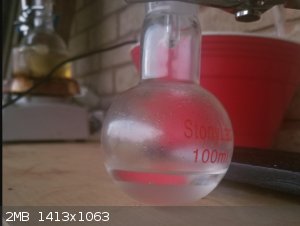
|
|
|
Herr Haber
International Hazard
    
Posts: 1236
Registered: 29-1-2016
Member Is Offline
Mood: No Mood
|
|
No cracks no nothing after cooling ? Pretty good glass !
The spirit of adventure was upon me. Having nitric acid and copper, I had only to learn what the words 'act upon' meant. - Ira Remsen
|
|
|
Cou
National Hazard
   
Posts: 958
Registered: 16-5-2013
Member Is Offline
Mood: Mad Scientist
|
|
h
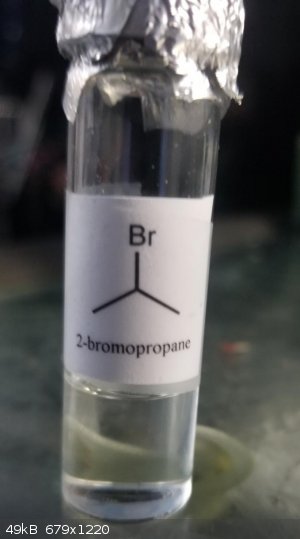
|
|
|
Bedlasky
International Hazard
    
Posts: 1239
Registered: 15-4-2019
Location: Period 5, group 6
Member Is Offline
Mood: Volatile
|
|
Hi.
Orange solid is (NH4)4H6[Mn(MoO4)6] and cream solid is MnMoO4. It's interesting that two compounds with similar composition have that much different
colours.
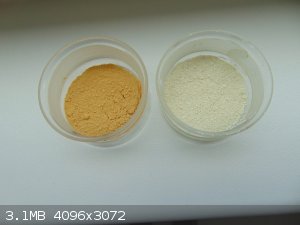
|
|
|
Lion850
National Hazard
   
Posts: 517
Registered: 7-10-2019
Location: Australia
Member Is Offline
Mood: Great
|
|
If you like green - the different green shades of praseodymium.
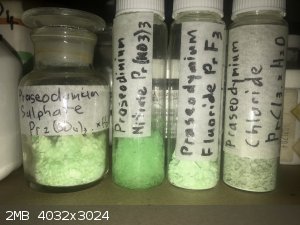
|
|
|
Lion850
National Hazard
   
Posts: 517
Registered: 7-10-2019
Location: Australia
Member Is Offline
Mood: Great
|
|
Lead iodide PbI2 drying on steam bath
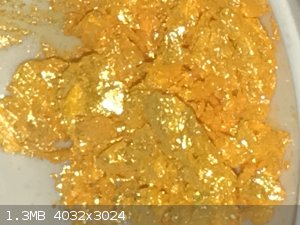
|
|
|
j_sum1
Administrator
       
Posts: 6320
Registered: 4-10-2014
Location: At home
Member Is Offline
Mood: Most of the ducks are in a row
|
|
When Lion850 posts in pretty pictures you know it is going to be good.
That gold is amazing!
|
|
|
woelen
Super Administrator
        
Posts: 8012
Registered: 20-8-2005
Location: Netherlands
Member Is Offline
Mood: interested
|
|
A nice picture of two comparable compounds I made: Ag3PO4 and Ag3AsO4.
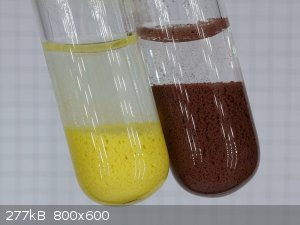
|
|
|
Bedlasky
International Hazard
    
Posts: 1239
Registered: 15-4-2019
Location: Period 5, group 6
Member Is Offline
Mood: Volatile
|
|
Woelen: Nice picture. Similar colour difference can be also seen in many chalcogenides (probably best colour differences can be seen in
CdO/CdS/CdSe/CdTe - the bigger anion the darker colour).
Mix of hydrated silicon dioxide, sodium silicomolybdate and silicomolybdenum blue.
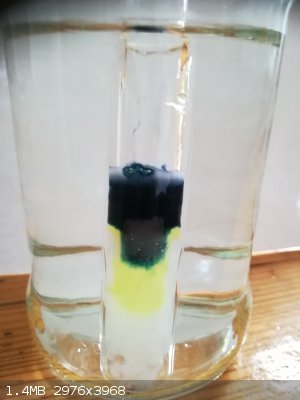
|
|
|
arkoma
Redneck Overlord
      
Posts: 1761
Registered: 3-2-2014
Location: On a Big Blue Marble hurtling through space
Member Is Offline
Mood: украї́нська
|
|
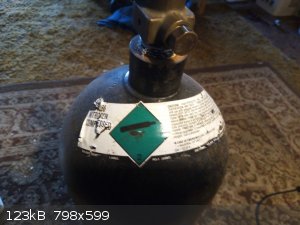
"We believe the knowledge and cultural heritage of mankind should be accessible to all people around the world, regardless of their wealth, social
status, nationality, citizenship, etc" z-lib
|
|
|
Lion850
National Hazard
   
Posts: 517
Registered: 7-10-2019
Location: Australia
Member Is Offline
Mood: Great
|
|
Copper acetate. The zoomed in photo is the copper acetate drying on a steam bath and shown in the crucible is the dry product. The color stayed very
much the same from wet to dry.
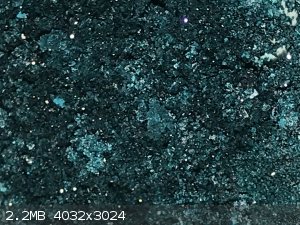 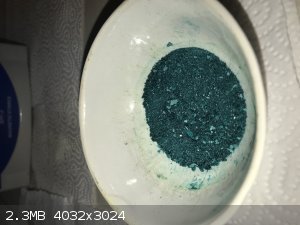
|
|
|
arkoma
Redneck Overlord
      
Posts: 1761
Registered: 3-2-2014
Location: On a Big Blue Marble hurtling through space
Member Is Offline
Mood: украї́нська
|
|
I absolutely love the color of Copper Acetate
"We believe the knowledge and cultural heritage of mankind should be accessible to all people around the world, regardless of their wealth, social
status, nationality, citizenship, etc" z-lib
|
|
|
Lion850
National Hazard
   
Posts: 517
Registered: 7-10-2019
Location: Australia
Member Is Offline
Mood: Great
|
|
arkona - I wonder how suited copper acetate is to grow big crystals? It's something I want to try.
|
|
|
sciece nerd
Harmless

Posts: 25
Registered: 27-8-2019
Member Is Offline
|
|
Very suitable, in fact I planned to buy some copper acetate just for growing crystals.
|
|
|
DraconicAcid
International Hazard
    
Posts: 4332
Registered: 1-2-2013
Location: The tiniest college campus ever....
Member Is Offline
Mood: Semi-victorious.
|
|
One of my books on crystal-growing recommended copper acetate, as well as calcium copper acetate, a mixed salt made by crystallizing a 4:1 mixture of
calcium acetate and copper acetate.
Please remember: "Filtrate" is not a verb.
Write up your lab reports the way your instructor wants them, not the way your ex-instructor wants them.
|
|
|
| Pages:
1
..
64
65
66
67
68
..
77 |